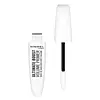What's inside
What's inside
 Key Ingredients
Key Ingredients

 Benefits
Benefits

 Concerns
Concerns

 Ingredients Side-by-side
Ingredients Side-by-side

Water
Skin ConditioningAcrylates Copolymer
Glyceryl Stearate
EmollientDisteardimonium Hectorite
StabilisingTalc
AbrasiveStearic Acid
CleansingPropylene Glycol
HumectantTriethanolamine
BufferingParaffin
PerfumingCera Alba
EmollientPropylene Carbonate
SolventSynthetic Wax
AbrasiveOleic Acid
EmollientEthylhexylglycerin
Skin ConditioningAlcohol Denat.
AntimicrobialPhenoxyethanol
PreservativeCera Microcristallina
Emulsion StabilisingBenzyl Alcohol
PerfumingPolyethylene
AbrasiveAscorbyl Palmitate
AntioxidantTocopherol
AntioxidantPanthenol
Skin ConditioningSodium Laureth Sulfate
CleansingSimethicone
EmollientGlycine Soja Oil
EmollientCellulose
AbsorbentTrisodium EDTA
Xanthan Gum
EmulsifyingAloe Barbadensis Leaf Extract
EmollientPotassium Sorbate
PreservativeMethylparaben
PreservativeArgania Spinosa Kernel Oil
EmollientRicinus Communis Seed Oil
MaskingSimmondsia Chinensis Seed Oil
EmollientTocopheryl Acetate
AntioxidantPropylparaben
PreservativeAmmonium Hydroxide
BufferingTetrasodium EDTA
Citric Acid
BufferingCocos Nucifera Oil
MaskingHippophae Rhamnoides Fruit Juice
Skin ConditioningTrideceth-9
EmulsifyingBisabolol
MaskingCI 77891
Cosmetic ColorantWater, Acrylates Copolymer, Glyceryl Stearate, Disteardimonium Hectorite, Talc, Stearic Acid, Propylene Glycol, Triethanolamine, Paraffin, Cera Alba, Propylene Carbonate, Synthetic Wax, Oleic Acid, Ethylhexylglycerin, Alcohol Denat., Phenoxyethanol, Cera Microcristallina, Benzyl Alcohol, Polyethylene, Ascorbyl Palmitate, Tocopherol, Panthenol, Sodium Laureth Sulfate, Simethicone, Glycine Soja Oil, Cellulose, Trisodium EDTA, Xanthan Gum, Aloe Barbadensis Leaf Extract, Potassium Sorbate, Methylparaben, Argania Spinosa Kernel Oil, Ricinus Communis Seed Oil, Simmondsia Chinensis Seed Oil, Tocopheryl Acetate, Propylparaben, Ammonium Hydroxide, Tetrasodium EDTA, Citric Acid, Cocos Nucifera Oil, Hippophae Rhamnoides Fruit Juice, Trideceth-9, Bisabolol, CI 77891
Water
Skin ConditioningAlcohol Denat.
AntimicrobialGlycerin
HumectantHydroxyethylcellulose
Emulsion StabilisingPentylene Glycol
Skin ConditioningPhenoxyethanol
PreservativePanthenol
Skin ConditioningPolysorbate 21
EmulsifyingMadecassoside
AntioxidantAcrylamide/Sodium Acryloyldimethyltaurate Copolymer
Emulsion StabilisingOctyldodecanol
EmollientIsohexadecane
EmollientSodium Hyaluronate
HumectantArginine
MaskingSerine
MaskingCitric Acid
BufferingGlutamic Acid
HumectantPolysorbate 80
EmulsifyingSodium Hydroxide
BufferingSorbitan Oleate
Emulsifying2-Oleamido-1,3-Octadecanediol
Skin ConditioningWater, Alcohol Denat., Glycerin, Hydroxyethylcellulose, Pentylene Glycol, Phenoxyethanol, Panthenol, Polysorbate 21, Madecassoside, Acrylamide/Sodium Acryloyldimethyltaurate Copolymer, Octyldodecanol, Isohexadecane, Sodium Hyaluronate, Arginine, Serine, Citric Acid, Glutamic Acid, Polysorbate 80, Sodium Hydroxide, Sorbitan Oleate, 2-Oleamido-1,3-Octadecanediol
Ingredients Explained
These ingredients are found in both products.
Ingredients higher up in an ingredient list are typically present in a larger amount.
Alcohol Denat. is an alcohol with a denaturant property. It is created by mixing ethanol with other additives.
This ingredient gets a bad rep because it is irritating and drying - mostly due to its astringent property. Astringents draw out natural oils in tissue, constricting pores and leaving your skin dried out.
However, alcohol denat. is not all that bad.
Due to its low molecular weight, alcohol denat. tends to evaporate quickly. One study on pig skin found half of applied alcohol evaporated in 10 seconds and less than 3% stayed on skin.
This also helps other ingredients become better absorbed upon application.
Studies are conflicted about whether this ingredient causes skin dehydration. One study from 2005 found adding emollients to propanol-based sanitizer decreased skin dryness and irritation. Another study found irritation only occurs if your skin is already damaged.
Small amounts of alcohol are generally tolerated by oily skin or people who live in humid environments.
The rule of thumb is if this alcohol is near the end of an ingredients list, it will probably not affect your skin much.
Also...
This ingredient has antimicrobial and solvent properties.
The antimicrobial property helps preserve products and increase their shelf life. As a solvent, it helps dissolve other ingredients.
Other types of astringent alcohols include:
Learn more about Alcohol Denat.Citric Acid is an alpha hydroxy acid (AHA) naturally found in citrus fruits like oranges, lemons, and limes.
Like other AHAs, citric acid can exfoliate skin by breaking down the bonds that hold dead skin cells together. This helps reveal smoother and brighter skin underneath.
However, this exfoliating effect only happens at high concentrations (20%) which can be hard to find in cosmetic products.
Due to this, citric acid is usually included in small amounts as a pH adjuster. This helps keep products slightly more acidic and compatible with skin's natural pH.
In skincare formulas, citric acid can:
While it can provide some skin benefits, research shows lactic acid and glycolic acid are generally more effective and less irritating exfoliants.
Most citric acid used in skincare today is made by fermenting sugars (usually from molasses). This synthetic version is identical to the natural citrus form but easier to stabilize and use in formulations.
Read more about some other popular AHA's here:
Learn more about Citric AcidPanthenol is a common ingredient that helps hydrate and soothe the skin. It is found naturally in our skin and hair.
There are two forms of panthenol: D and L.
D-panthenol is also known as dexpanthenol. Most cosmetics use dexpanthenol or a mixture of D and L-panthenol.
Panthenol is famous due to its ability to go deeper into the skin's layers. Using this ingredient has numerous pros (and no cons):
Like hyaluronic acid, panthenol is a humectant. Humectants are able to bind and hold large amounts of water to keep skin hydrated.
This ingredient works well for wound healing. It works by increasing tissue in the wound and helps close open wounds.
Once oxidized, panthenol converts to pantothenic acid. Panthothenic acid is found in all living cells.
This ingredient is also referred to as pro-vitamin B5.
Learn more about PanthenolPhenoxyethanol is a preservative that has germicide, antimicrobial, and aromatic properties. Studies show that phenoxyethanol can prevent microbial growth. By itself, it has a scent that is similar to that of a rose.
It's often used in formulations along with Caprylyl Glycol to preserve the shelf life of products.
Water. It's the most common cosmetic ingredient of all. You'll usually see it at the top of ingredient lists, meaning that it makes up the largest part of the product.
So why is it so popular? Water most often acts as a solvent - this means that it helps dissolve other ingredients into the formulation.
You'll also recognize water as that liquid we all need to stay alive. If you see this, drink a glass of water. Stay hydrated!
Learn more about Water